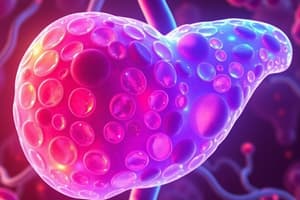Podcast
Questions and Answers
What is the primary cause of type 1 diabetes?
What is the primary cause of type 1 diabetes?
- Down-regulation of insulin receptors in target cells
- The person's immune system destroys the pancreatic beta cells (correct)
- A shortage of insulin production due to aging
- Obesity and lack of exercise
In type 2 diabetes, what is the primary reason for high blood glucose levels?
In type 2 diabetes, what is the primary reason for high blood glucose levels?
- Inability to properly metabolize fatty acids
- Pancreatic beta cells are destroyed by the immune system
- Target cells become less sensitive to insulin (correct)
- Lack of insulin production by the pancreas
Which population has the highest incidence of type 1 diabetes?
Which population has the highest incidence of type 1 diabetes?
- Whites in the United States
- African Americans in the United States
- Asians in the United States
- People in northern Europe, especially Finland (correct)
What is a potential treatment approach for type 1 diabetes involving transplantation?
What is a potential treatment approach for type 1 diabetes involving transplantation?
Which of the following is a common symptom of untreated type 1 diabetes?
Which of the following is a common symptom of untreated type 1 diabetes?
What is a common treatment approach for type 2 diabetes?
What is a common treatment approach for type 2 diabetes?
What is the most common endocrine disorder?
What is the most common endocrine disorder?
What is the primary reason diabetes mellitus is the fourth leading cause of death in the United States?
What is the primary reason diabetes mellitus is the fourth leading cause of death in the United States?
What is the cause of the elevated level of parathyroid hormone in hyperparathyroidism?
What is the cause of the elevated level of parathyroid hormone in hyperparathyroidism?
What is the effect of the elevated level of parathyroid hormone in hyperparathyroidism?
What is the effect of the elevated level of parathyroid hormone in hyperparathyroidism?
What are the hallmarks of diabetes mellitus?
What are the hallmarks of diabetes mellitus?
What is the cause of the high blood glucose level in diabetes mellitus?
What is the cause of the high blood glucose level in diabetes mellitus?
Study Notes
Pancreatic Islet Disorders
- Pancreatic islet disorders can occur due to damage to the pancreatic islets or their blood supply during thyroidectomy surgery.
Hyperparathyroidism
- Elevated level of parathyroid hormone (PTH) is often caused by a tumor in one of the parathyroid glands.
- Elevated PTH causes excessive resorption of bone matrix, leading to high blood levels of calcium and phosphate ions, causing soft and fragile bones.
- High blood calcium levels promote kidney stone formation.
- Fatigue, personality changes, and lethargy are also seen in patients with hyperparathyroidism.
Diabetes Mellitus
- Diabetes mellitus is the fourth leading cause of death by disease in the United States, primarily due to cardiovascular system damage.
- Diabetes mellitus is caused by an inability to produce or use insulin.
- Hallmarks of diabetes mellitus are the three "polys": polyuria (excessive urine production), polydipsia (excessive thirst), and polyphagia (excessive eating).
Type 1 Diabetes
- Type 1 diabetes is caused by the immune system destroying pancreatic beta cells, resulting in little or no insulin production.
- Type 1 diabetes usually develops in people younger than age 20 and persists throughout life.
- By the time symptoms arise, 80-90% of islet beta cells have been destroyed.
Type 2 Diabetes
- Type 2 diabetes is more common than type 1, representing more than 90% of all cases.
- Type 2 diabetes often occurs in obese people over age 35.
- Clinical symptoms are mild, and high glucose levels can often be controlled by diet, exercise, and weight loss.
Ketoacidosis
- Ketoacidosis occurs when insulin is not present to aid glucose entry into body cells, causing cells to use fatty acids for energy production.
- Fatty acid breakdown leads to accumulation of organic acids called ketones, causing blood pH to fall.
- If left untreated, ketoacidosis can be fatal.
Studying That Suits You
Use AI to generate personalized quizzes and flashcards to suit your learning preferences.
Description
Test your knowledge on pancreatic islet disorders and hyperparathyroidism. Learn about the causes, symptoms, and effects of these endocrine system disorders.




